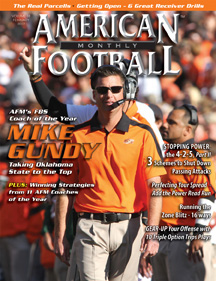Article CategoriesAFM Magazine
|
Speed Report - Movement Skills – Critical for Drill Effectivenessby: Dale BaskettFootball Speed Specialist © More from this issue Using drills for teaching and developing football movement is certainly not uncommon. However, breaking down the drills analytically is not the most common practice. Most drills are performed to provide reinforcement for certain football movements, usually relevant to a position. The movement patterns are supposed to create better agility and speed of movement with the use of cones or other equipment creating a challenge for player agility. Although there’s nothing wrong with that, there’s a problem with any drill that’s not effectively providing the best mechanical efficiency and movement control skills. The following drills will help coaches utilize more effective mechanical body control methods which will allow players to perform faster during movement transitions.
|
|
|||||||
| HOME |
MAGAZINE |
SUBSCRIBE | ONLINE COLUMNISTS | COACHING VIDEOS |
Copyright 2025, AmericanFootballMonthly.com
All Rights Reserved





